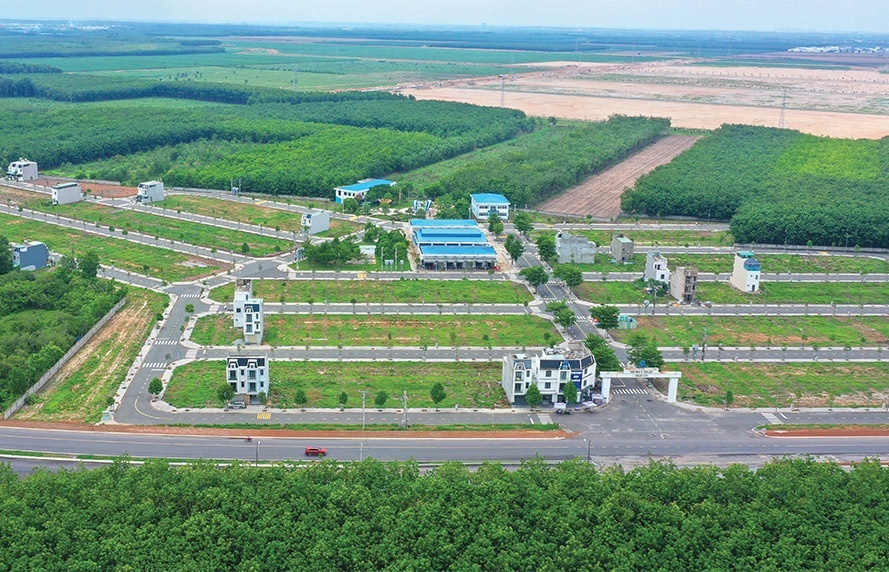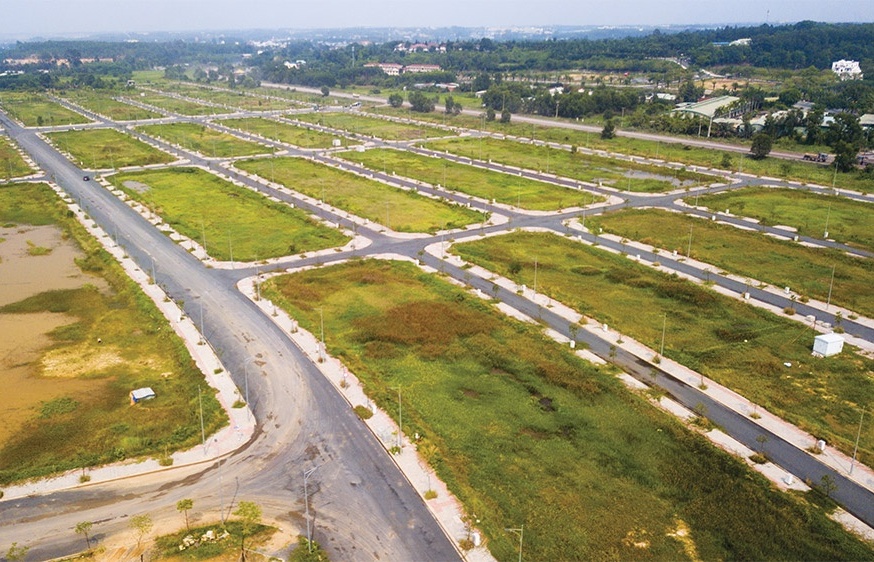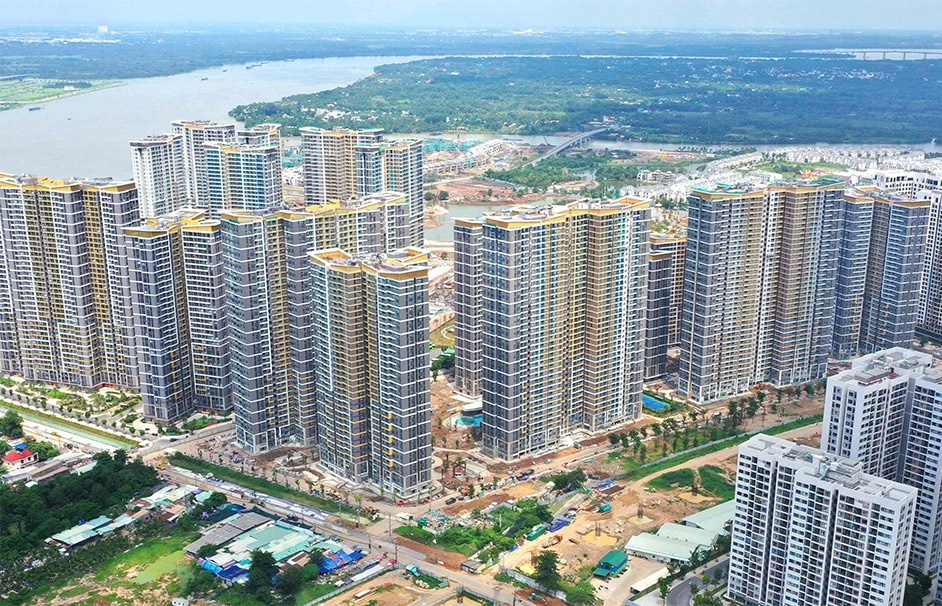Firm foundation laid to build land laws
The Land Law was enacted two years ago - yet it has fully come to life. The reform spirit, which has been carried out in line with the acceleration of Vietnam’s industrialisation and modernisation, has been reflected in the resolution of the Ninth Party Congress’s Central Committee’s seventh convention.
 |
The above system appears sufficient, yet it was misinterpreted when applied and implemented at local level. Land issues have long been over-complicated, as they are linked with the living space of people, farmers’ fields and over-inflated values have made these issues more complex.
Since 1953, Vietnam’s land policies have undergone five major changes: Land reform (1953); agricultural collectivisation (1959); land ownership belonging to all people (1980); the government allocating land to households for long-term and stable use (1986); and restructuring land in line with the country’s industrialisation and modernisation (1996).
Each of these fluctuations created vast social change and affected the life of numerous families. The fourth reform was a breakthrough in the country’s renovation process, reallocating agricultural collective land to households. That helped turn Vietnam from a “hungry” country into the world’s third biggest rice exporter.
We are implementing the fifth reform now, and a remarkable volume of formerly agricultural land has been transformed for investment and development purposes. This might be a new breakthrough that transforms stationary capital into a movable capital for internal-strength-based investment.
The past two years have seen a lot of effort made to improve the systems concerning land laws, land-use planning, land-related finance and administrative management. State agencies at all levels have shown much travail in bringing these laws to the reality.
However, discrepancies remain, and the land-use management system has failed to marry with the country’s demand for sustainable socio-economic development, to eliminate corruption and waste, to cut back land-related disputes, and to raise land-use efficiency.
There are seven critical discrepancies in land management and usage.
First, the legal system related to land has a great number of loopholes and lacks feasibility. More alarmingly, it conflicts with many other laws. Laws are still not uniform or comprehensive, which makes them very difficult to apply.
For example, although the Land Law and the Construction Law were approved in the same National Assembly’s working session, and took effect on the same day, the former stipulates the government as being responsible for site clearance and investors must pay in advance the compensation costs which will be subtracted later when they fulfill financial obligations with the government. Meanwhile, the latter stipulates that investors are responsible for site clearance.
Another case in point is that the Land Law does not allow land exchange, while the Housing Law does, but it fails to mention the land on which a house is built. If the Housing Law’s regulations are followed to the letter, a house would then occupy land owned by another party, or must be relocated to a new block.
Second, land-use planning is rife with shortcomings simply because it is unreasonable and unfeasible, and falls far short of economic, social and environmental efficiency.
The current planning systems do not work toward the same end. For instance, a piece of land might be used for different purposes under the land-use plan or the construction plan. In many cases, although new plans have been adopted, the old ones have not been eliminated, leading to the existence of two plans at the same time, meaning neither can be implemented.
Third, the land-related financial system has not been synchronised with other legal aspects, especially with the land-related laws. Although the Land Law was implemented two years ago, associated taxes remain unchanged. Only regulations concerning the income tax on business land use right exchanges have been issued.
The Land Law sets a one-pricing land system, but prices are set by provincial peoples’ committees, and are only 50 to 70 per cent of the market value. Such a massive price difference does not meet the interests of those whose land is recovered, while those allocated with land-use rights can earn great profit from their exchange.
Fourth, expertise among administrative agencies and management officials, particularly those at district and communal levels, is low. As a result, laws are not properly implemented, land use plans are distorted, and administrative procedures become overly complicated.
Fifth, cadastral documentation system lacks uniformity. Therefore, only about half of non-agricultural land, and 80 per cent of agricultural land, has been granted with land-use right certificates. Official cadastral documentation has been created for only 30 per cent of total land area.
In addition, the Housing Law stipulates that land with a house is registered through a different system while the unified Real Estate Registration Law has yet to be passed to the National Assembly for consideration.
Sixth, corruption and waste in land management are still serious issues. Many violations have appeared organised, taking place on a large scale and have brought about serious problems. There are six key areas of corruption in this field:
- Officials abuse power and position to seize or share land from projects that use land for forestation, development of rural residential areas, construction of houses for workers and resettlement areas.
- Officials allocate land to their relatives who are not qualified for ownership; or tolerate lower-level officials who illegally sell allocated land.
- Officials allocate fraudulent compensation and site clearance schemes to embezzle state funds.
- Officials earn personal profits through establishing or adjusting landmarks in residential areas, public facilities and transport routes.
- Management officials deliberately create problems in land clearance procedures, to facilitate and skim from increased cash flow into land-use right allocation, land lease, or land-use right certification and adjustment.
Seventh, land-related lawsuits and disputes are on the rise. By the end of 2005, there had been 18,000 cases, 70.6 per cent of which were concerning compensation and site clearance, 10 per cent for violations of land laws, 8.6 per cent boundary disputes, 6.8 per cent land recovery, and 4 per cent were ‘other’ issues.
More importantly, 83.4 per cent of these cases have yet to be addressed, or are only just being addressed for the first time. The Land Law issued in 2003 aims to transfer most of these cases to the courts, but to date, the courts have taken on only 3 per cent of the cases. Given the low level of trust in the courts, many defendants want to have their cases tackled at central-level agencies.
The above-mentioned problems must be resolved for proper Land Law implementation, as well as land-related investigation and supervision. This is the only way to perfect the land-related legal system.
In future, it will be necessary to eliminate any corruption and waste in land management, which requires a transparent management system, including transparent registration documentation, managerial agencies, officials, administrative procedures, planning and financial systems.
Transparency will eliminate corruption and waste.
Once public interests are guaranteed, land-related lawsuits and disputes should be unlikely.
It may take five years to achieve this level of transparency, which will help realise the goal of putting the land-use restructuring in a right track with labour and investment restructuring processes, to reach the target of fully industrialising Vietnam within the next 10 years.
No. 777/September 4-10, 2006
What the stars mean:
★ Poor ★ ★ Promising ★★★ Good ★★★★ Very good ★★★★★ Exceptional
 Tag:
Tag:
Related Contents
Latest News
More News
- Trump's trade policies could shape Vietnam's economic outlook: Dragon Capital (November 15, 2024 | 16:56)
- The One Destination partners with Singapore investor and institutional fund to build ESG real estate complex (November 11, 2024 | 10:32)
- Stabilising measures must sit alongside land price hikes (November 07, 2024 | 09:56)
- CapitaLand Development records strong bookings for Orchard Hill (November 07, 2024 | 08:19)
- Public transport and real estate: The rise of Transit Oriented Development (November 05, 2024 | 15:06)
- Funding flows to second-tier localities (November 03, 2024 | 15:24)
- Hanoi has long road to travel in becoming a smart city (November 03, 2024 | 15:00)
- Nam Long Group hands over keys to Akari City Phase 2 (October 30, 2024 | 18:29)
- KTG Industrial expands industrial footprint at Taitronics 2024 (October 29, 2024 | 14:46)
- Deal signed for sustainable development at Prodezi Eco-Industrial Park (October 26, 2024 | 10:02)




















 Mobile Version
Mobile Version